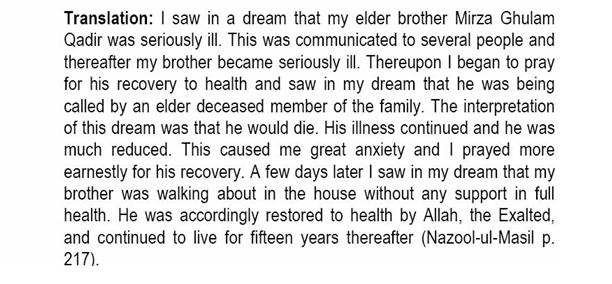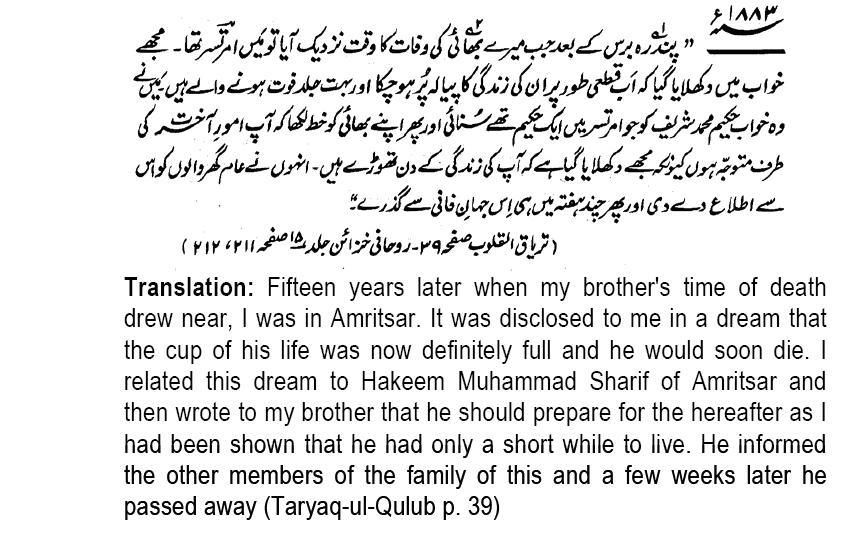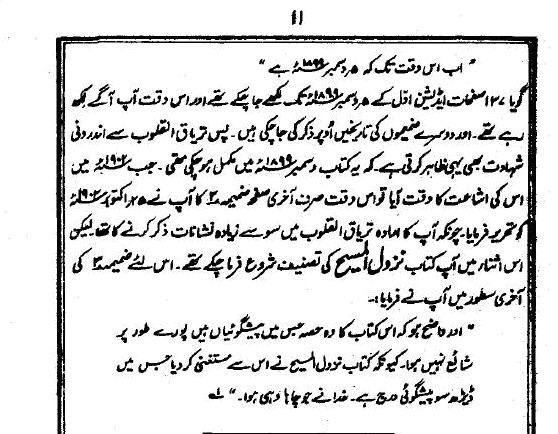Prophesies of Mirza II – Death of his Brother
Introduction
We have dealt this issue in our previous article according to evidence from Urdu tadkirah now let’s have a look at its English version. This version does contain same deliberate misrepresentations of the facts; dishonest claims based on invention rather then truthful scholarly enquiry and examination of the original evidence.
Preface of English Tadkirah
Preface of the English Tadkirah states the following;

According to the preface Zafrullah Khan rendered Tadkirah into English. We introduce selected portions from the foreword by Zafrullah Khan.
Foreword from English Tadkirah

It is demonstratively apparent that Zafrullah is making suggestions to the readers that according to him, his English rendering of the tadkirah contains dreams, vision and verbal revelations vouchsafed to Mirza or in other words he is categorically claiming that these are divine revelations from Allah.
Zafrullah in his foreword further wrote;

Zafrullah is keen to present to the readers that Mirza received divine revelations not due to his righteousness or his exalted status. Mirza’s revelations were not upsurge of his mind. Mirza received it as a bounty from God. Zafrullah’s intention is to convince his Western readers that these revelations are not just the result of Mirza’s state of mind but result of communication with God.
He gave examples from Quran, which are off course only applicable to the revelations received by Prophet Muhammad SAW. Zafrullah’s purpose to quote Quranic verses here is to imply that like Prophet Muhammad SAW, Mirza too received pure revelations (nauzobillah) from Allah SWT.
Zafrullah then gave example of another Verse of Quran to imply it again that revelation is bounty from Allah SWT and His SWT words descend on whosoever He SWT pleases. These are categorical statements that Mirza allegedly received divine revelations like Prophet Muhammad SAW and other True Prophets of Allah SWT.
We turn our attention to the evidence from tadkirah which is the main purpose of our current and previous Article on this subject.


In English Tadkirah, the Urdu text from Urdu version displayed first then the translation by Zafrullah Khan is given. At the end of the translation Zafrullah Khan has given reference to the original writings of these alleged revelations, these references are also given in Urdu tadkirah.
Controversy on Prophesies continues
We move to the second part of this prophecy; in our earlier article we have already displayed proofs from pages 595 and 596 of Nazul-ul-Massih; according to Mirza 1887 is the year of the prophecy for the death of his brother. We found following revelation in English Tadkirah on the death of Mirza’s brother, this revelations falsely state 1883 as year of Ghulam-e-Qadir’s death. Once again desperation of this cult is evident to prove Mirza’s prophesy correct.

Lets turn to the evidence from the source of this particular alleged revelations. In Taryaq-ul-Qulub, unlike Nazul-ul-Messih there are no dates or years given for the prophesies. In Taryaq-ul-Qulub incident number 17 narrate the sickness of Ghulam Qadir. The text is similar to the text in Nazul-e-Messih. That evidence is displayed in our previous article. Incident number 18 relates to the death of Ghulam Qadir.

This evidence from the original writings of Mirza in Taryaq-ul-Qulub states absolutely no date or year of this prophecy unlike Nazul-ul-Messih which categorically states it as 1887.
Dishonesty of the compilers of tadkirah is quite apparent they purposefully inserted the year of 1883 to make Mirza look credible; while deliberately ignoring the evidence from Nazul-e-Messih which state the year of this prophecy as 1887. English tadkirah is not exempt from this invention and downright fraudulent presentation of Mirza’s writings.
Some facts about Taryaq-ul-Qulub
Writing and publications of this book is surrounded by controversies, which may be subject of a future article but for the purpose of this article we will restrict ourselves to the point in discussion. First of all the online copy of this book, the title page does not give any date/year of its publications. Long details and solemn testimonies are given in the introduction of the Volume 15. According to this introduction Taryaq-ul-Qulub;
I- Mirza started to write in July 1899
II- By December 1899 it was completed.
III- It was published in 1902.
We will restrict our comments for the time being to Quadiani’s claims that this book was completed in 1899, sixteen years after the death of Ghulam Qadir in 1883 according to the book on the history of Punjab; evidence displayed in our previous article on this topic; twelve years after Mirza’s Prophecy according to Nazul-e-Messih.
Credibility of Zafrullah Khan
Quadianis hold Zafrullah Khan in great respect and claim that he was amongst the most intelligent and knowledgeable Scholar of their cult. We are restricting our comments to this topic; commenting on the basis of the evidence available and displayed.
We like to draw readers’ attention to some glaring facts which indicate that Zafrullah Khan was neither entirely truthful or a credible person.
1- For first Prophecy, apart from Urdu tadkirah as a sound scholar he must have checked the original source of that prophecy.
2- He should have found that Mirza categorically written he received this revelation in 1871 and not in 1868 as falsely claimed in Urdu Tadkirah; reproduced and repeated in English rendering.
3- He should have checked that according to Mirza he received revelations on his brothers death in 1887 and not in 1883 as second revelation in English Tadkirah quoted. He surely could not have missed it. It is the next Prophecy in Nazul-e-Messih.
4- He must have checked the source document in Taryaq-ul-Qulub; therefore he was aware that this book does not show any year of this prophecy.
Taryaq-ul-Qulub and Nazul-ul-Messih
There is one crucial evidence available in the internal record, as we have mentioned above, there were apparent problems on the dates of completion, printing and publication of Taryaq-ul-Qulub.

“137 Pages of this edition one were written by 5th December 1899. And that time he (Mirza) was writing further. Dates of other Editions are listed above. Thus, internal evidence from Taryaq-ul-Qulub indicates that this book was completed by December 1899. At the time of its publication in 1902; he (Mirza) only wrote the last page, supplement number 3 on 25th October 1902. He (Mirza) intended to write more than 100 signs but during this period he (Mirza) started to write Nazul-e-Messih, therefore, in the last lines of supplement number 3 he (Mirza) writes;
“It should be made clear that the part of the book which contains prophecies was not published completely, because the book Nazul-e-Messih made it redundant, which has more than 150 Prophecies, whatever, Khuda willed happen.”
Display of this evidence serves two purpose; first to show to the readers that there were problems and controversies surrounding these books, which even Mirza was well aware of, secondly the fact that Mirza has written Nazul-e-Messih after Taryaq-ul-Qulub.
Not to mention that according to internal evidence Mirza had until 25th October 1902 to make whatever changes he wanted to make before Taryaq-ul-Qulub publication. Another interesting fact pointed out by Mirza is that Prophesies section in Taryaq-ul-Qulub was not completed.
Fact remains even though Mirza didn’t write any dates/years in Taryaq-ul-Qulub of these particular prophesies but he indeed write the dates in Nazul-e-Messih which he has written later according to his own admission. It establishes without shadow of any doubt that Taryaq-ul-Qulub was not correcting Nazul-e-Messih; it was indeed the other way.
Conclusion
We have once again demonstrated that not only work by Zafrullah is very suspect but also that he has deliberately ignored glaring evidence from the originals, which indicated that the dates given in tadkirah are missing in the case of Taryaq-ul-Qulub and are incorrect in the case of Nazul-e-Messih.
It is very crucial for prophesies, which by nature rely solely on the timing, when it was foretold and time of its fulfillment.
Instead of examining and presenting the original evidence and being truthful to its readers, Zafrullah has tried to add weight to the evidence for the benefit of the English readers in the Foreword of English Tadkirah; he has introduced Quranic verses to deceptively support this cult’s claim that somehow Mirza was recipient of divine revelations.
Zafrullah’s intentions are very clear; he has given clear indications that his intended audience is in Western countries. He definitely wanted to give the impression albeit falsely to the Western world that Mirza is credible and should be accepted as an alleged Prophet.
No comments:
Post a Comment